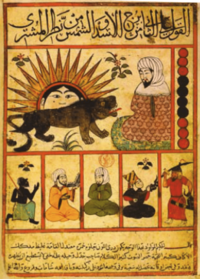Abu Ma'shar al-Balkhi facts for kids
Quick facts for kids
Abu Ma'shar al-Balkhi
|
|
|---|---|

Page of a 15th-century manuscript of the "Book of nativities" (BNF Arabe 2583 fol. 15v).
|
|
| Born | 10 August 787 |
| Died | 9 March 886 (aged 98) Wāsiṭ, Iraq, Abbasid Caliphate
|
| Academic background | |
| Influences | Aristotle and Ptolemy |
| Academic work | |
| Era | Islamic Golden Age (Abbasid era) |
| Main interests | Astrology, Astronomy |
| Influenced | Al-Sijzi, Albertus Magnus, Roger Bacon, Pierre d'Ailly, Pico della Mirandola. |
Abu Ma'shar al-Balkhi (born August 10, 787 – died March 9, 886), also known as Albumasar, was a famous Persian astrologer. He lived during the Islamic Golden Age and worked in the Abbasid court in Baghdad. Many people thought he was the greatest astrologer of his time.
Even though he didn't invent many new ideas, his practical guides for training astrologers were very important. These guides greatly influenced thinkers in the Muslim world. Later, they were translated and also shaped ideas in Europe and Byzantium.
Contents
Life of Abu Ma'shar
Abu Ma'shar was born in Balkh, a city in a region called Greater Khurasan. This area was a key place for the Abbasid Revolution in the early 700s. People there kept many of their old cultural traditions.
He likely moved to Baghdad when al-Maʾmūn was the caliph (ruler) from 813 to 833. He lived on the west side of Baghdad, near a gate called Bab Khurasan.
Abu Ma'shar was part of a group of smart people from Khurasan who studied old Persian writings. He was known for combining many different ideas in his work. He faced some trouble for his astrology work, even getting into a disagreement with a caliph. There is a story that he was punished for practicing astrology.
He was first a scholar of hadith, which are sayings and actions of the Prophet Muhammad. It's said that he only started studying astrology when he was 47 years old, around 832 or 833.
He had a big argument with al-Kindi, a leading Arab philosopher. This argument made Abu Ma'shar realize he needed to study "mathematics" to understand philosophical ideas better.
Once, he made a prediction that came true, but the Caliph al-Musta'in was not happy about it. Abu Ma'shar said, "I hit the mark and I was severely punished."
A writer named al-Nadim mentioned that Persian kings used to collect the best writing materials. They kept their science books safe in a fortress in Isfahan. This collection still existed in al-Nadim's time, in the 900s.
Another writer, Amir Khusrav, said that Abu Ma'shar traveled to Benaras (Varanasi) in India. He reportedly studied astronomy there for ten years.
Abu Ma'shar is believed to have died at the age of 98 in Wāsiṭ, a city in eastern Iraq. This happened on March 9, 866.
Abu Ma'shar's Works
Most of Abu Ma'shar's books on astronomy no longer exist. However, we can still learn about them from summaries in later astronomers' writings or from his astrology books.
- Kitāb al‐madkhal al‐kabīr (The Great Introduction): This was an important introduction to astrology. It was translated into Latin and Greek many times starting in the 1000s. It had a big impact on Western thinkers like Albert the Great.
- Kitāb mukhtaṣar al‐madkhal (The Abridged Introduction): This was a shorter version of the book above. It was translated into Latin by Adelard of Bath.
- Kitāb al‐milal wa‐ʾl‐duwal (Book on Religions and Dynasties): This is probably his most important work. Famous scholars like Roger Bacon and Pierre d'Ailly wrote about it.
- Kitāb taḥāwīl sinī al-ʿālam (Flowers of Abu Ma'shar): This book used horoscopes to look at months and days of the year. It was a guide for astrologers. John of Seville translated it in the 1100s.
- Kitāb taḥāwil sinī al‐mawālīd (Book of the Revolutions of the Years of Nativities): This book was translated into Greek around 1000 AD, and then from Greek into Latin in the 1200s.
- Kitāb mawālīd al‐rijāl wa‐ʾl‐nisāʾ (Book of Nativities of Men and Women): This book was very popular in the Islamic world. Parts of it were copied into an illustrated manuscript called the Book of Wonders around 1390.
Latin and Greek Translations
Abu Ma'shar's "Introduction" (Kitāb al‐mudkhal al‐kabīr), written around 848, was first translated into Latin in 1133. This translation was called Introductorium in Astronomiam. Another, shorter translation was made in 1140.
Some historians believe that Abu Ma'shar's writings were very important for bringing the ideas of Aristotle back to European scholars before the mid-1100s.
One of his translated works, De magnis coniunctionibus, was first printed in 1488/9. It was printed again in Venice in 1506 and 1515.
See also
- Islamic astrology
- List of Iranian scientists
Images for kids


